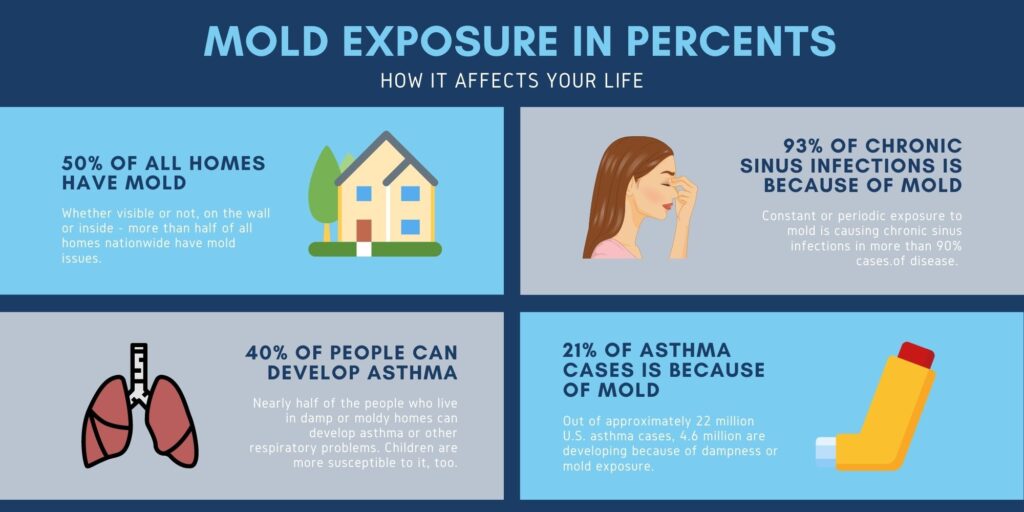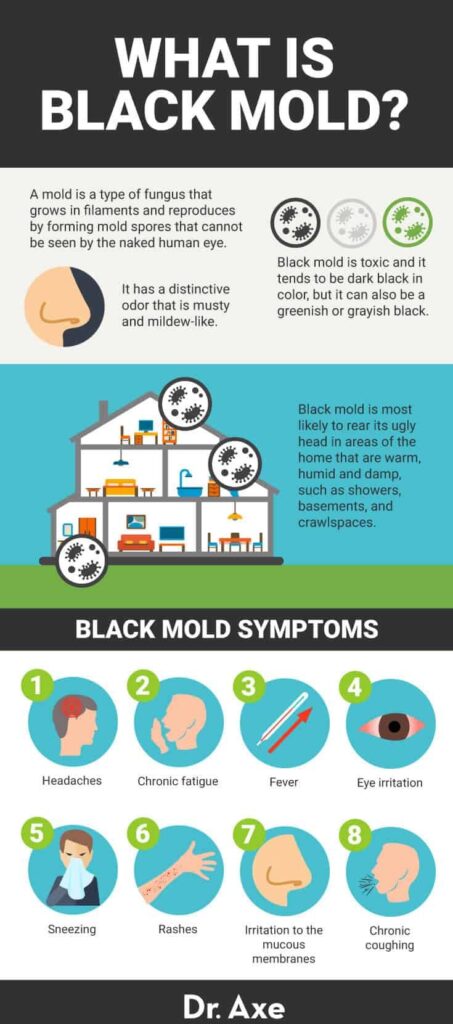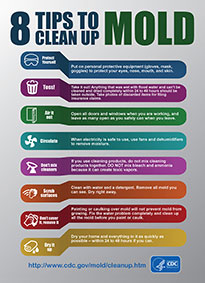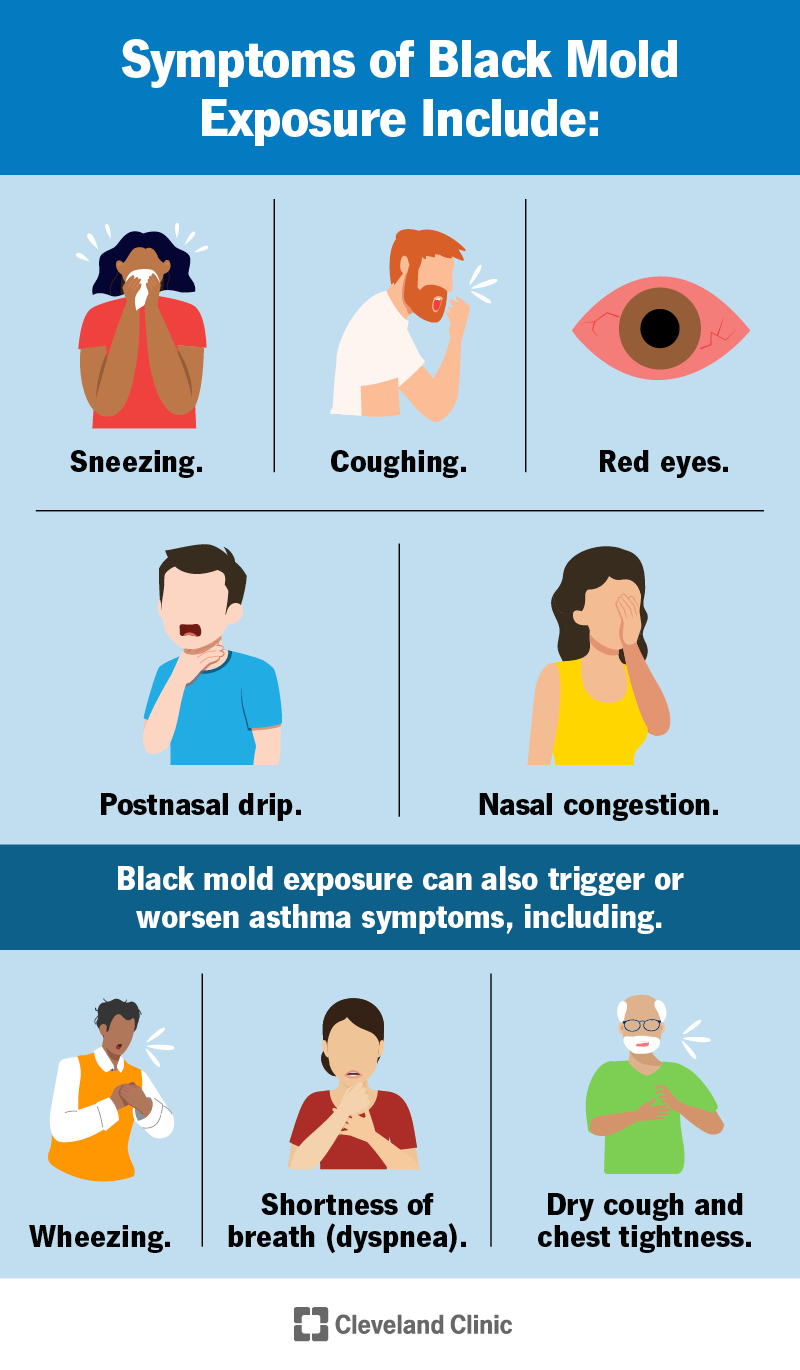Imagine living in a home that unknowingly poses a threat to your family’s health. Mold, a silent and often undetectable intruder, can wreak havoc on your well-being without you even realizing it. This article aims to shed light on the symptoms of mold exposure in your house and how you can protect your loved ones from its harmful effects. Learn how to spot the signs, take precautionary measures, and create a safe haven for your family’s health.
Common Signs of Mold Exposure
Musty Odor
One of the most common signs of mold exposure is a musty odor in your home. Mold has a distinct smell that is often described as earthy or damp. If you detect this musty odor in your house, it is a clear indication that there may be mold growing somewhere.
Visible Mold Growth
Another obvious sign of mold exposure is the presence of visible mold growth. Mold can appear as black or green patches on walls, ceilings, or other surfaces. If you see any signs of mold in your home, it is important to take immediate action to prevent further spread and protect your family’s health.
Allergic Reactions
Mold exposure can trigger allergic reactions in some individuals. Symptoms may include sneezing, itching, runny nose, and watery eyes. These allergic reactions can be particularly bothersome for individuals who already have allergies or asthma.
Respiratory Issues
Exposure to mold can also cause respiratory issues such as coughing, wheezing, and shortness of breath. This is especially true for individuals with pre-existing respiratory conditions, such as asthma or chronic obstructive pulmonary disease (COPD).
Specific Symptoms to Look Out For
Nasal Congestion
Nasal congestion is a common symptom of mold exposure. It occurs when the nasal passages become swollen or inflamed due to mold spores in the air. This can make it difficult to breathe through the nose and may lead to a stuffy or runny nose.
Sneezing
Frequent sneezing is another symptom that may indicate mold exposure. Mold spores can irritate the nasal passages, triggering a sneezing reflex as the body tries to remove them. If you find yourself sneezing frequently in your home, mold could be the culprit.
Coughing
Mold exposure can also result in persistent coughing. Mold spores can irritate the respiratory system, leading to an irritating cough that may worsen over time. If you have been experiencing a persistent cough that does not seem to go away, it is important to consider the possibility of mold in your home.
Wheezing
Wheezing is a whistling or squeaking sound that occurs when air flows through narrowed airways. It is a common symptom of asthma and can also be triggered by mold exposure. If you notice wheezing sounds when breathing, particularly during or after being in your home, mold could be contributing to the problem.
Shortness of Breath
Shortness of breath is a concerning symptom that should not be ignored. Mold exposure can lead to inflammation in the airways, causing breathing difficulties and a sensation of not getting enough air. If you experience shortness of breath, especially in your own home, it is crucial to investigate the presence of mold.
Skin Irritation
In some cases, mold exposure can cause skin irritation. This may present as redness, itching, or a rash. If you notice any unexplained skin issues, it is worth considering whether mold could be a contributing factor.
Eye Irritation
Mold spores can also irritate the eyes. Symptoms of eye irritation due to mold exposure may include redness, itching, watering, or a burning sensation. If your eyes feel consistently irritated while in your home, mold could be the cause.
Headaches
Headaches are a common symptom of mold exposure. Mold can release volatile organic compounds (VOCs) that can trigger headaches in sensitive individuals. If you experience frequent headaches, especially when at home, it is important to investigate the possibility of mold.
Fatigue
Feeling constantly tired and lacking energy can be a sign of mold exposure. Mold exposure can release toxins into the air that can affect your overall well-being, leading to feelings of fatigue and lethargy. If you find yourself feeling exhausted and drained on a regular basis, mold could be a contributing factor.
Difficulty Concentrating
Mold exposure can also impact cognitive function and make it difficult to concentrate. The presence of mold in your home can create an unhealthy environment that affects your ability to focus and think clearly. If you are experiencing difficulty concentrating, it is worth considering whether mold could be a factor.
Effects of Mold Exposure on Health
Allergic Reactions
As mentioned earlier, mold exposure can trigger allergic reactions in susceptible individuals. This can include symptoms such as sneezing, itching, runny nose, and watery eyes. Allergic reactions to mold can range from mild to severe, depending on the individual’s sensitivity and the amount of mold exposure.
Asthma Exacerbation
Mold exposure can worsen the symptoms of asthma in individuals who already have the condition. The presence of mold spores in the air can irritate the airways and trigger asthma attacks. This can lead to wheezing, coughing, shortness of breath, and chest tightness.
Respiratory Infections
Exposure to mold can also increase the risk of respiratory infections. Mold can impair the immune system and make individuals more susceptible to infections such as bronchitis and pneumonia. This is particularly concerning for vulnerable populations, such as children and the elderly.
Sinusitis
Mold exposure has been linked to chronic sinus infections, also known as sinusitis. Mold spores can irritate the sinuses and lead to inflammation, congestion, and recurrent sinus infections. If you find yourself frequently dealing with sinusitis, mold in your home could be a contributing factor.
Fungal Infections
Certain types of mold can cause fungal infections in the skin, nails, or respiratory system. These infections can be difficult to treat and may require medical intervention. If you have recurrent fungal infections, it is important to consider whether mold exposure could be a factor.
Toxic Mold Syndrome
Prolonged exposure to certain types of toxic mold can lead to a condition known as toxic mold syndrome. Symptoms can vary but may include fatigue, muscle aches, joint pain, headaches, difficulty concentrating, memory problems, and sensitivity to light and sound. If you suspect toxic mold exposure, it is crucial to seek medical attention.
Neurological Issues
There is some evidence to suggest that mold exposure can impact neurological function. Mold toxins can affect the central nervous system, leading to symptoms such as difficulty concentrating, memory problems, mood changes, and even seizures. Further research is needed to fully understand the extent of the neurological effects of mold exposure.
Immune System Suppression
Exposure to mold can suppress the immune system, making individuals more susceptible to infections and other illnesses. This is particularly concerning for individuals with weakened immune systems, such as those undergoing chemotherapy or with HIV/AIDS. Mold exposure can further compromise their already compromised immune function.
Vulnerable Populations at Higher Risk
Children
Children are particularly vulnerable to the health effects of mold exposure. Their respiratory systems are still developing, and their immune systems may not be fully mature. This can make them more susceptible to the respiratory and allergic symptoms associated with mold exposure.
Elderly Individuals
Elderly individuals may also be more vulnerable to the health effects of mold exposure. As aging occurs, the immune system weakens, and respiratory function may decline. These factors can make older adults more susceptible to the respiratory symptoms and infections associated with mold exposure.
Pregnant Women
Pregnant women should be especially cautious when it comes to mold exposure. Mold toxins can potentially harm the developing fetus and lead to complications. Pregnant women who suspect mold exposure should consult with their healthcare provider to ensure the safety of themselves and their baby.
Individuals with Respiratory Conditions
People with pre-existing respiratory conditions, such as asthma or COPD, are at a higher risk of experiencing worsening symptoms due to mold exposure. Mold spores can exacerbate respiratory issues and lead to more frequent and severe asthma attacks or episodes of shortness of breath.
People with Weakened Immune Systems
Individuals with weakened immune systems, either due to medical conditions or certain medications, are particularly susceptible to the health effects of mold exposure. Mold can further compromise their immune function and increase the risk of infections and other complications.

Identifying Mold in Your Home
Visual Inspection
One way to identify mold in your home is through a visual inspection. Look for any signs of mold growth, such as black or green patches, on walls, ceilings, floors, or other surfaces. Pay close attention to areas that are prone to moisture, such as bathrooms, kitchens, and basements.
Quality Testing
If you suspect mold in your home but cannot see any visible signs, you may consider getting a quality test done. This involves collecting air or surface samples to be analyzed by a professional laboratory. Quality testing can help determine the presence and type of mold in your home, providing valuable information for remediation efforts.
Professional Assessment
In some cases, it may be necessary to seek the expertise of a professional mold assessor. They will thoroughly inspect your home, conduct tests, and provide a comprehensive assessment of the mold situation. A professional assessment can help identify the extent of the mold problem and recommend appropriate remediation measures.
Preventing Mold Growth
Controlling Moisture Levels
One of the most effective ways to prevent mold growth in your home is by controlling moisture levels. Make sure there are no water leaks or excessive humidity in your living spaces. Fix any leaks promptly, use dehumidifiers if necessary, and ensure proper ventilation to keep indoor humidity levels low.
Proper Ventilation
Proper ventilation is crucial for preventing mold growth. Ensure that your home has adequate airflow, especially in areas prone to moisture, such as bathrooms and kitchens. Use exhaust fans or open windows when cooking, showering, or doing laundry to remove excess moisture from the air.
Effective Insulation
Proper insulation can help prevent condensation and moisture buildup, which can contribute to mold growth. Ensure that your home is adequately insulated, especially in areas such as attics, basements, and crawl spaces. Insulation helps maintain stable indoor temperatures and reduces the chances of moisture-related issues.
Regular Cleaning
Regular cleaning is essential for preventing mold growth. Keep your home clean and free of dust and debris that can provide a suitable environment for mold. Pay special attention to areas that are prone to moisture, such as bathrooms and kitchens, and use mold-inhibiting cleaners when necessary.
Addressing Water Leaks
Water leaks should be addressed promptly to prevent mold growth. Inspect your home regularly for any signs of leaks, such as damp spots, water stains, or musty odors. If you discover a leak, fix it immediately and dry the affected area thoroughly to prevent mold from taking hold.

Steps to Take If You Suspect Mold Exposure
Seek Medical Attention
If you suspect mold exposure and are experiencing symptoms, it is important to seek medical attention. Your healthcare provider can evaluate your symptoms, conduct necessary tests, and provide appropriate treatment or referrals. They can also help determine if your symptoms are indeed associated with mold exposure.
Identify and Remove the Source
Identifying and removing the source of mold is crucial for addressing the problem. If you can see visible mold growth, take immediate action to remove it safely. In some cases, professional mold remediation may be necessary to ensure proper removal and prevent further contamination.
Thoroughly Clean Affected Areas
If you have visible mold growth, it is important to clean affected areas thoroughly. Use appropriate cleaning products and techniques to remove mold from surfaces. Be sure to wear protective equipment, such as gloves and masks, to prevent exposure to mold spores during the cleaning process.
Repair Water Damages
Addressing any water damages in your home is crucial to prevent mold growth. Fix leaks, repair plumbing issues, and ensure proper drainage to prevent excess moisture. This will help create an environment that is less conducive to mold growth.
Consider Professional Mold Remediation
In some cases, professional mold remediation may be necessary to address the problem effectively. Professional mold remediation experts have the knowledge, experience, and specialized equipment to safely remove mold and prevent further contamination. If you have a large or severe mold problem, it is advisable to consult with professionals.
Potential Legal and Insurance Issues
Liability
If you discover mold in your home and it is affecting your health, there may be liability issues to consider. In certain situations, landlords or homeowners may be held responsible for the presence of mold and its impact on occupants’ health. It is important to understand your rights and consult legal professionals if necessary.
Homeowner’s Insurance Coverage
Whether or not your homeowner’s insurance covers mold-related damages and remediation depends on your policy. Some policies may provide coverage for mold damage caused by sudden and accidental events, such as a burst pipe. However, coverage for mold caused by ongoing issues like humidity or water leaks may be limited or excluded. Review your policy carefully and consult with your insurance provider for clarification.
Professional Assessment and Documentation
In cases where legal or insurance claims are involved, having a professional mold assessment and documentation can be essential. A professional assessment report detailing the mold problem, its extent, and recommended remediation measures can provide valuable evidence to support your claims and negotiations.
Legal Remedies
In certain situations, legal remedies may be pursued to address mold-related issues. This can involve filing a lawsuit against responsible parties or seeking compensation for health damages, property damage, or other related costs. Consultation with legal professionals specializing in mold-related cases is advised in such circumstances.

Importance of Regular Home Maintenance
Preventing Mold
Regular home maintenance is the key to preventing mold growth and ensuring a healthy living environment. By addressing water leaks, controlling moisture levels, and keeping your home clean, you can significantly reduce the risk of mold infestation.
Early Detection
Regular home maintenance allows for early detection of potential mold problems. By regularly inspecting your home and taking prompt action to address any issues, you can prevent mold from spreading and causing further damage.
Keeping a Healthy Environment
Maintaining a healthy home environment is crucial for the well-being of you and your family. By implementing proper ventilation, controlling moisture, and practicing regular cleaning and maintenance, you can create a living space that promotes good health and well-being.
Educating Your Family about Mold Exposure
Informing about Symptoms
It is important to educate your family about the symptoms of mold exposure. Make sure everyone in your household is aware of the common signs of mold exposure, such as allergic reactions, respiratory issues, and other symptoms mentioned earlier in this article. Understanding these symptoms can help prompt early detection and action.
Teaching Prevention Methods
Teach your family about the importance of preventing mold growth in your home. Explain the significance of controlling moisture levels, maintaining proper ventilation, and practicing regular cleaning and maintenance. Involve everyone in the household in these preventive measures to create a cooperative and health-conscious environment.
Highlighting Risks and Impacts
Emphasize the risks and impacts of mold exposure to your family. Help them understand that mold can have detrimental effects on their health and well-being. By highlighting the potential health risks associated with mold, you can motivate your family to take mold prevention and remediation seriously.
Promoting Healthy Habits
Encourage your family to adopt healthy habits that can prevent mold growth and maintain a healthy living environment. These habits may include promptly fixing water leaks, cleaning up spills and moisture promptly, using exhaust fans in the bathroom and kitchen, and keeping living spaces clean and clutter-free. By promoting these habits, you can create a mold-resistant environment for your family.
In conclusion, protecting your family’s health from mold exposure is of utmost importance. By being aware of the common signs and symptoms, understanding the health effects, preventing mold growth, taking necessary steps if exposure is suspected, addressing any legal or insurance issues, maintaining your home properly, and educating your family, you can ensure a healthier and safer living environment. Remember, early detection and prevention are key in safeguarding your family against the detrimental effects of mold exposure.

